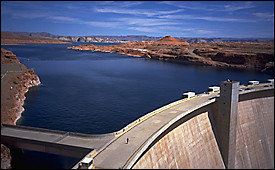November 13, 1998
[1 2]
 The damming of the Colorado River at Glen Canyon is high on the West’s “greatest ecological sins” list. Still, it’s visited each year by nearly three million vacationers who have casually shrugged off, or could care less about, the impacts of the dam.
The damming of the Colorado River at Glen Canyon is high on the West’s “greatest ecological sins” list. Still, it’s visited each year by nearly three million vacationers who have casually shrugged off, or could care less about, the impacts of the dam.
“Charley” at the Page, Ariz. chamber of commerce was ready to go home, but he graciously opened up 15 minutes after closing one early June evening and doled out maps, brochures and campsite information.
“Welcome to Page, boys!” After the long drive from Denver, we were happy to be there.
Yet we walked into Page with mixed feelings. The vast inland sea known as Lake Powell is full of haunting vistas with hundreds of parched, colorful canyons flooded with Colorado River water. It’s almost beautiful enough to make you forget what Glen Canyon Dam destroyed. In fact, forgetting is a big part of the Lake Powell experience.
The dimensions of Lake Powell and the surrounding one-million-acre-plus Glen Canyon National Recreation Area are immense. Sprawling Lake Powell touches 1,960 miles of shoreline. Seven national parks, seven national monuments, and many state parks, historical sites, ghost towns, prehistoric native ruins and sculpted mesa, buttes and geologic wonders surround Lake Powell.
 This area of southern Utah/northern Arizona is rich in resources for the outdoors enthusiast.
This area of southern Utah/northern Arizona is rich in resources for the outdoors enthusiast.
Construction of the 583-foot-high Glen Canyon Dam began in 1956. Before that time, the wild Colorado served as a formidable barrier to east-west travel across the Colorado Plateau. Two hydroelectric generators began producing power in 1966. In 1980, the 183-mile-long reservoir finally filled up and reached “full pool level.” A lucrative economy based on “recreation” was also born, almost completely based on burning gasoline. Nearby, as the turbines at Glen Canyon Dam spin, the Navajo Generating Station produces more power, burning the coal of the rich Black Mesa Coal Field. (For more information about Black Mesa, check out “The Black Mesa Syndrome,” by Judith Nies.)
Page’s life blood flows with the millions of BTUs of energy created and burned here.
Visitors to Lake Powell drive hundreds of miles – 649 miles from Denver and 540 miles from Los Angeles – and once here, they buy copious quantities of gasoline to fill up their speed boats, fishing boats, personal watercraft, house boats, trucks, cars, motorhomes, dirt bikes, all-terrain-vehicles, etc. Gasoline lingers in the air here. It doesn’t mix well with ghosts of the Basketmakers, the people who once inhabited these high-altitude canyons and plateaus.
Our short trip to Lake Powell took place in greater Page, Ariz., the southwestern corner of the Glen Canyon National Recreation Area. Glen Canyon Dam and the Carl Hayden Visitor Center are centered in Page and are worth a visit. The visitor’s center contains information and exhibits about the cultural and geologic history of the area. Tours of the dam are available.
Lone Rock campground

North of Page about 10 miles (across the border into Utah) is Lone Rock campground, a beautiful stretch of sandy beach with nearly every type of gasoline-burning device available parked nearby.
Across the water, the tops of solitary, tall buttes rise like ancient giants flooded up to their necks in the water. In between the whines of the motors, if you forget about them, the beach is a wonderful place to pitch a tent and watch the sunset.
Continued –>
[1 2]